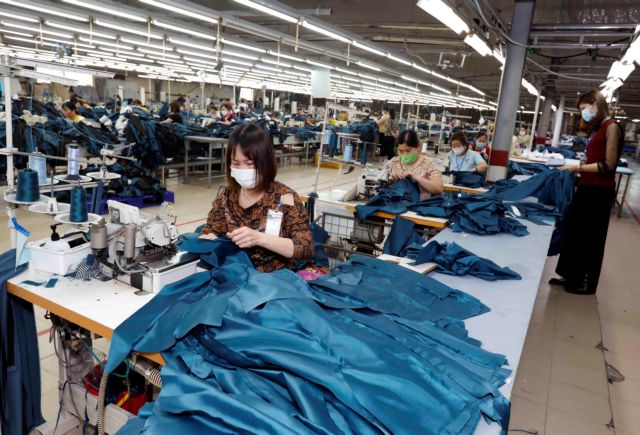 Economy
Economy

 |
| A garment factory in Hưng Yên Province. In 2021, the UK was among the top six for clothes from Việt Nam on alibaba.com. — VNA/VNS Photo |
HÀ NỘI — Vietnamese firms are urged to use online platforms to expand their market reach in the UK now that the UK-Việt Nam Free Trade Agreement (UKVFTA) has come into effect, experts said.
With revenue of US$117.7 billion in 2021, the UK is the fourth largest market for e-commerce in the world, placing it ahead of Germany and behind Japan, according to global provider of market and consumer data Statista.
Last year, the UK e-commerce market contributed to a worldwide growth rate of 15 per cent with an increase of 12 per cent, Statista said.
The biggest player in the UK e-commerce market is amazon.co.uk. The store had revenue of $17.1 billion in 2021. It was followed by tesco.com and argos.co.uk which gained respective revenue of $9.5 billion and $6.3 billion. Altogether, these top three stores account for 30 per cent of online revenue in the UK.
Meanwhile, Việt Nam is regarded as the second largest e-commerce market in Southeast Asia, only after Indonesia, according to a global e-commerce report in the first half of 2022 by Metric.vn.
The prolonged COVID-19 pandemic has also given fresh impetus to the country’s e-commerce industry which recorded growth of up to 53 per cent in 2021, making it the optimal form of transactions for individuals and firms.
With such rapid growth, experts said it is time for both sides to raise the bar on this platform in order to facilitate online business.
According to Bùi Thanh Hằng, head of the International Cooperation Office under the Ministry of Industry and Trade’s E-commerce and Digital Economy Agency, the UKVFTA has allowed new means of market entry to emerge, notably e-commerce.
B2B and B2C are traditional forms of business for this platform, but new forms are also beginning to take root, including online showrooms and national pavilions, she said.
In order to help firms keep pace with these innovations, the government is urged to continue to refine the legal framework and develop programmes that improve firms’ capacity. At the same time, firms themselves should embrace digital transformation and put it on top of their agenda to be able to expand their market footprint via e-commerce.
In a bright spot, Vietnamese businesses have effectively taken advantage of Amazon's innovations to strongly develop and build the "Made-in-Việt Nam" brand on the world map, thereby leaving a strong mark of the country's economy on the international market including the UK.
At the same time, several Vietnamese goods have affirmed their positions in another e-commerce platform in the UK, alibaba.com. In 2021, the UK positioned itself among the top 10 buyers of food and beverage, top six for clothes, and came in fourth in terms of furniture from Việt Nam.
Notably, it was the second-largest buyer of Vietnamese cosmetics on that e-commerce website.
 |
| Nguyễn Thanh Phong, founder of CamLamOnline checks online orders via its website. — VNA/VNS Photo |
{ "id": "RZ0wKSogWC", "type": "myToolImages", "data": { "data": "" } }
Despite the serious impacts of the COVID-19 pandemic on Việt Nam's trade and service activities, the country's e-commerce sector still maintained a stable growth rate of 16 per cent in 2021. The proportion of e-commerce retail revenue in the total retail sales of goods and services reached 7 per cent last year, up 27 per cent over the same period in 2020.
According to the Vietnam E-commerce White Paper 2022, Việt Nam's e-commerce value will likely reach $39 billion by 2025, ranking second in terms of e-commerce growth in Southeast Asia. In addition, it is forecast that Việt Nam's e-commerce economy would see a number of annual records this year.
The State, meanwhile, aims to make e-commerce one of the pioneering sectors of the digital economy, where the advanced technologies of the Fourth Industrial Revolution are widely applied to increase the efficiency of the business cycle, contributing to the modernisation of the distribution system, improving the competitiveness of enterprises, promoting the development of the domestic market and export.
Under the national e-commerce development plan for the 2021-25 period, Việt Nam’s e-commerce market is striving to be the second-best in Southeast Asia by 2025 and to become the most promising e-commerce market in the region.
As per the plan, 50 per cent of small and medium-sized enterprises will operate on e-commerce trading platforms (including social media with e-commerce features); 40 per cent of enterprises will take part in e-commerce activities on mobile applications by 2025.
Revenues of business-to-consumer sales are projected to increase to $35 billion by 2025, accounting for 10 per cent of Viet Nam’s total retail sales of goods and services.
The Government also expects that 55 per cent of the population will do online shopping by 2025, with average consumer spending rising to $600 by 2025 from $202 in 2018. — VNS




